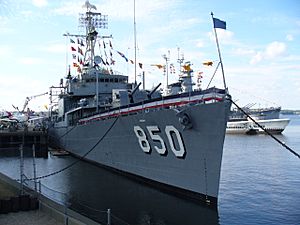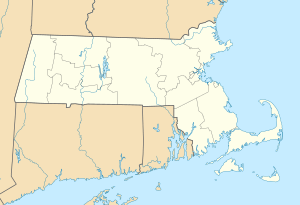USS Joseph P. Kennedy Jr. facts for kids

Joseph P. Kennedy Jr. underway in 1962
|
|
| History | |
|---|---|
| Name | Joseph P. Kennedy Jr |
| Namesake | Joseph P. Kennedy Jr. |
| Builder | Fore River Shipyard |
| Laid down | 2 April 1945 |
| Launched | 26 July 1945 |
| Sponsored by | Miss Jean Kennedy Smith |
| Commissioned | 15 December 1945 |
| Decommissioned | 2 July 1973 |
| Stricken | 1 July 1973 |
| Identification | |
| Nickname(s) | Joey P |
| Status | Museum ship at Battleship Cove |
| Badge |  |
| General characteristics | |
| Class and type | Gearing-class destroyer |
| Displacement |
|
| Length | 390 ft 6 in (119.02 m) |
| Beam | 40 ft 10 in (12.45 m) |
| Draft | 14 ft 4 in (4.37 m) |
| Installed power | 4 × Babcock & Wilcox 615 psi (4.24 MPa) 850 °F (454 °C) superheated D-Type express boilers |
| Propulsion | 2 sets of high pressure, low pressure and cruising turbines (General Electric or Westinghouse) 60,000 shp (45,000 kW); 2 shafts and 12.5-foot (3.8 m) four-bladed propellers |
| Speed | 35.25 knots (65.28 km/h; 40.56 mph) |
| Range | 5,800 mi (5,000 nmi; 9,300 km) at 15 knots (28 km/h; 17 mph) |
| Complement |
|
| Sensors and processing systems |
|
| Armament |
|
| Aircraft carried | Drone Anti-Sub Helicopter (DASH) |
| Notes | Fuel capacity of 96,000 US gal (360,000 L; 80,000 imp gal) |
 |
|
| Built | 1945 |
| NRHP reference No. | 76000231 |
| Significant dates | |
| Added to NRHP | 11 December 1989 |
| Designated NHL | 29 June 1989 |
The USS Joseph P. Kennedy Jr. (DD-850) is a famous former United States Navy destroyer. This ship was named after Lieutenant Joseph P. Kennedy Jr.. He was a naval aviator and the older brother of future President John F. Kennedy.
The Joseph P. Kennedy Jr. served the Navy for many years. It was involved in important events like the Cuban Missile Crisis. It also helped recover astronauts from space missions. Today, you can visit the ship as a museum ship in Battleship Cove, Fall River, Massachusetts. It's a special part of history!
Contents
Building and Early Years (1945–1950)
The USS Joseph P. Kennedy Jr. was built by Bethlehem Steel in Quincy, Massachusetts. It was launched on July 26, 1945. Lieutenant Kennedy's sister, Miss Jean Kennedy, was the ship's sponsor. The ship officially joined the Navy on December 15, 1945.
In February 1946, the new destroyer sailed for training in the Caribbean. Robert F. Kennedy, Joseph's younger brother, was on this trip. He served as an apprentice seaman.
The ship returned to its homeport in Newport in April 1946. For the next few months, it helped train Naval Reserve members. Later that year, it sailed to Chile and Venezuela with other Navy ships.
Throughout 1947, the destroyer operated along the East Coast and in the Caribbean. It then joined the 6th Fleet in the Mediterranean Sea. This fleet helped keep peace in Europe during a time of change. The Joseph P. Kennedy Jr. visited many ports before returning home in June 1948.
The ship spent the rest of 1948 practicing how to fight submarines. In 1949, it made two training trips to the Caribbean. It also served as the flagship for Destroyer Squadron 18 in the Mediterranean.
Service in Korea and Around the World (1950–1960)
When the Korean War began, the Joseph P. Kennedy Jr. prepared for action. It sailed to Japan in January 1951. From there, it joined Task Force 77 off Korea.
From February to April, the ship protected aircraft carriers. These carriers were attacking enemy positions. Later, it helped patrol the Taiwan Straits. This patrol prevented more fighting in the area.
In May, the ship arrived off Wonsan to support Allied forces. It bombarded enemy positions almost constantly. This duty was very important for the operation.
After its combat duty, the Joseph P. Kennedy Jr. did not go straight home. Instead, it sailed west to travel all the way around the world! It visited places like Singapore, Bahrain, and Naples. The ship finally returned to Newport in August 1951.
For the next few years, it conducted battle practice and training. It also made more trips to the Mediterranean. In 1955, it took part in Arctic training exercises. The ship visited Norway and West Germany.
In 1956, the Joseph P. Kennedy Jr. carried Naval Academy students for a training cruise. It also took part in more training operations. In 1957, it sailed to the Mediterranean again. It helped with carrier operations and NATO exercises off Norway.
The ship returned to the Mediterranean in 1958. It spent April in the Persian Gulf before heading back to Newport. After some repairs, it carried midshipmen again in 1959.
The Joseph P. Kennedy Jr. represented the Navy at the opening of the St. Lawrence Seaway. This big event included both President Dwight D. Eisenhower and Queen Elizabeth II. The ship even sailed through the Seaway to Chicago! In 1960, it returned to the Mediterranean with other large carriers.
Major Events and Modernization (1961–1964)
In January 1961, the Joseph P. Kennedy Jr. sailed to Washington, D.C. It was there for the inauguration of John F. Kennedy. He was the brother of the ship's namesake.
The ship also played a role in the early Project Mercury space missions. It helped with space shots in February and April.
Later in 1961, the ship went to the New York Naval Shipyard for a big upgrade. This was called a Fleet Rehabilitation and Modernization (FRAM) overhaul. It received new equipment for fighting submarines. It also got a new helicopter landing deck and hangar. These changes made the ship more modern and useful.
After its upgrades, the ship went through testing in Guantanamo Bay, Cuba. It returned in August 1962.
Soon after, the Joseph P. Kennedy Jr. was called into action. In October 1962, Soviet ballistic missiles were discovered in Cuba. President Kennedy ordered a naval quarantine (blockade) around Cuba. The ship took an active part in this blockade. It even sent a team to board a Lebanese merchant ship. This action helped ease the Cuban Missile Crisis. The ship stayed on patrol until December 1962.
In 1963, the destroyer conducted training exercises. In 1964, it went on another Mediterranean cruise. It also took part in Operation Steel Pike I. This was a very large amphibious operation. The Joseph P. Kennedy Jr. helped protect the task force.
Space Missions and Final Years (1965–1973)
In January 1965, the Joseph P. Kennedy Jr. helped test new Polaris submarines. It then went for repairs at the Boston Naval Shipyard.
One of the ship's most exciting jobs was helping with space missions. In November 1965, it took a special position southeast of Bermuda. It was part of the recovery team for Gemini 6 and Gemini 7. These were important missions where two spacecraft met in orbit. The missions were a success, and the ship returned home in December.
In February 1966, the Joseph P. Kennedy Jr. went back to the Mediterranean. It spent four months taking part in air defense and anti-submarine operations. It sailed all over the Mediterranean Sea. The ship returned to Newport in July.
Later that year, it helped with recovery operations for Gemini 12. In March 1967, it sailed for the 6th Fleet again. It cruised the Mediterranean, then went through the Suez Canal to the Red Sea and Indian Ocean. After a long journey around the Cape of Good Hope, it returned to Newport.
As the Vietnam War ended, the Navy reduced its fleet. The Joseph P. Kennedy Jr. was taken out of service in 1973. However, because of its famous name and connection to the Kennedy family, plans were made to save it.
A Museum Ship Today
After leaving active service, the Joseph P. Kennedy Jr. became a museum ship. It moved to Fall River, Massachusetts, and is now part of the Battleship Cove Museum. You can visit it there!
The ship serves as an official memorial. It honors citizens from Massachusetts who lost their lives in the Korean War and Vietnam War. It also houses the Admiral Arleigh Burke National Destroyermen's Museum.
In 2000, the Joseph P. Kennedy Jr. was used in a movie called Thirteen Days. The movie was about the Cuban Missile Crisis. The ship played itself and another destroyer. Real Navy sailors and reservists acted as the crew. Some parts of the ship, like the radar and guns, were made to move for the movie scenes.
Awards and Honors
The USS Joseph P. Kennedy Jr. earned many awards during its service. These include:
- Combat Action Ribbon
- Navy Meritorious Unit Commendation
- Navy Expeditionary Medal
- American Campaign Medal
- World War II Victory Medal
- Navy Occupation Service Medal (with "EUROPE" clasp)
- China Service Medal
- National Defense Service Medal (with one star)
- Korean Service Medal (with two battle stars)
- Armed Forces Expeditionary Medal
- Presidential Unit Citation (South Korea)
- United Nations Korea Medal
- Korean War Service Medal (South Korea)
It's important to note that while the ship displays the Asiatic–Pacific Campaign Medal at Battleship Cove, it was not in the correct area during World War II to officially earn that medal.
See also


